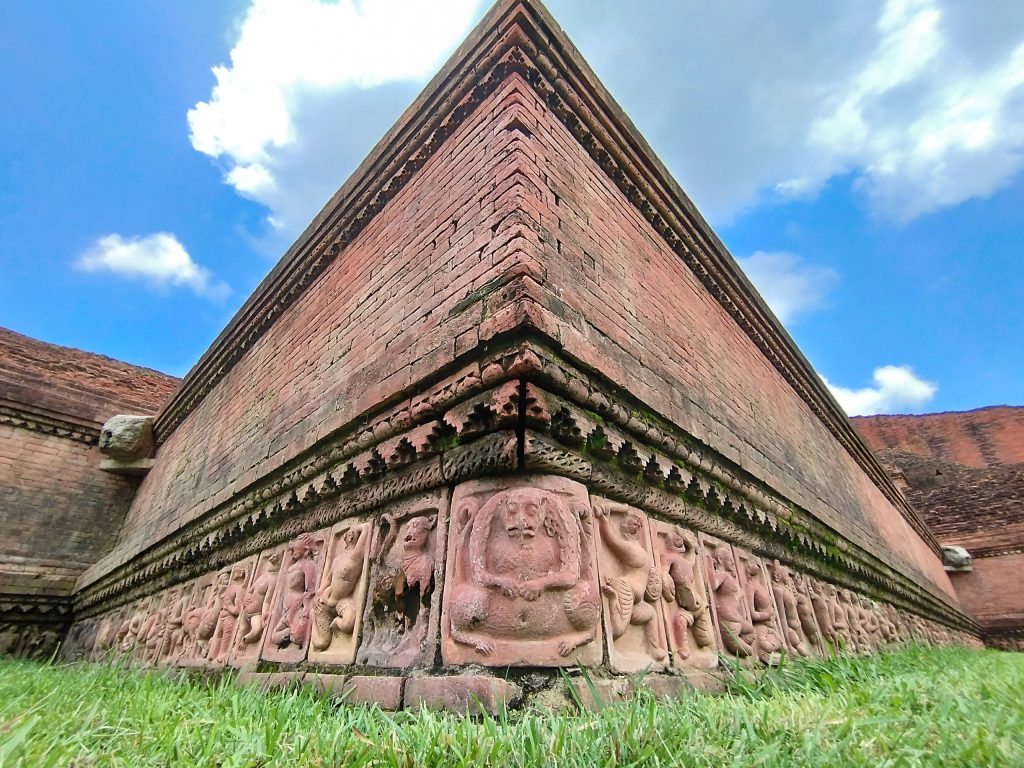By Ashikuz Zaman
All that remains are the ruins of Paharpur Buddhist monastery, known as the Sompur MohaVihara. Located just about 10km away from the Bodolgachi upazilla in Naogaon, it was built during the reign of Sri Dharmapaladeva, the second king of the Pal Dynasty, in the 9th Century. This ancient structure was excavated in 1871 by Sir Cunningham, which in 1985 was listed a UNESCO World Heritage site in 1985

A glorious history
The Paharpur monastery was a centre for Buddhist practices for over 300 years. In those days, devotees and scholars from Tibet, China, Malaysia, Indonesia and Myanmar would flock to Paharpur to pray and study here.
The monastery spans 922 ft from north to south, and 919 ft from east to west. The complex had some 177 cells that housed the devotees. Taking pride of place at the centre of the structure is a temple about 400ft long and 350ft wide, and standing 70ft high, whose outer walls are decorated with terracotta floral motifs and sculptures from Hindu and Buddhist religious scripture. The outer walls of the monastery complex are about 20ft wide, and house another temple. The quadrangular monastery complex used to be surrounded by a thick perimeter wall, which housed a series of some 92 cells. It is theorised that the devotees lived in these cells, and that later some of these cells were converted to prayer rooms.

Remains of the day
The main entrance to the Vihara is located on the north side. Until 1984, there used to be a pond at the mouth of the entryway. During the excavation of 1984-85, a cache of silver coins from the reign of Khalifa Harul Al Rashid were discovered at this location. These are now displayed at the museum adjacent to the monastery, along with several sculptures, artifacts and engravings.
What is left of the monastery include the ruins of the temple at the centre chamber. The walls of this architectural masterpiece are decorated with some 2000 terracotta plaques. These were added to the brick walls of the 400ft long and 350ft wide structure. A number of baths and latrines have been constructed on a platform outside the Buddhist monastery at a distance of about 27 meters from the southern wall. These are connected to Cell no. 102 of the monastery via a raised walkway.

Nearby structures
Outside the walls of the Vihara, a beautiful ghat can be seen from the southeast corner. This is known as the Shondhabotir Ghat. It is believed that Shondhaboti, the daughter of Raja Moudolon used to bathe here. Within the monastery complex, the ruined remains of several structures can be found dotted about the open courtyards. These structures once included the administrative building, dining halls, kitchens, altars, wells, etc.
About 365m east to the Vihara is located the Saytapir’s Hold. The Tara Temple of this estate houses the ruins of some 132 shrines. About 50 terracotta plaques, eight-armed goddesses and terracotta seals inscribed with Buddhist religious doctrines have been found in the temple premises. Another temple can be seen just 12m west of the Shondaboti’r Snan Ghat. It is known locally as the Gandheshwari Temple. The temple is 6.7m long and 3.5m wide. The southern wall of the temple houses the idol of the Buddhist goddess Padmapani and the front wall is decorated with lotus flower motifs.

How to get to Paharpur Buddhist Vihara
By bus: From anywhere in the country, you first get to the Naogaon Baludanga bus terminal in Naogaon, and take the bus to Paharpur. The Vihara is located some 32km from Naogaon, and will set you back by 40-50 BDT. Another option is to go from Joypurhat by bus or auto rickshaw. The Paharpur Buddhist Vihar is just 13 km away from Jaipurhat.
By train: Get down at Jamalganj railway station in Joypurhat and go to the Viharawhich is 5 km away by van or auto rickshaw.

Where to stay at Paharpur
There is no accommodation available in Paharpur, but you may find some hotels in central Naogaon. Notable hotels include Hotel Abakash, Hotel Farial, Hotel Jamuna, Hotel Raj, Hotel Agomoni, Hotel Plabon, Chisty Motel and Hotel Swarani













